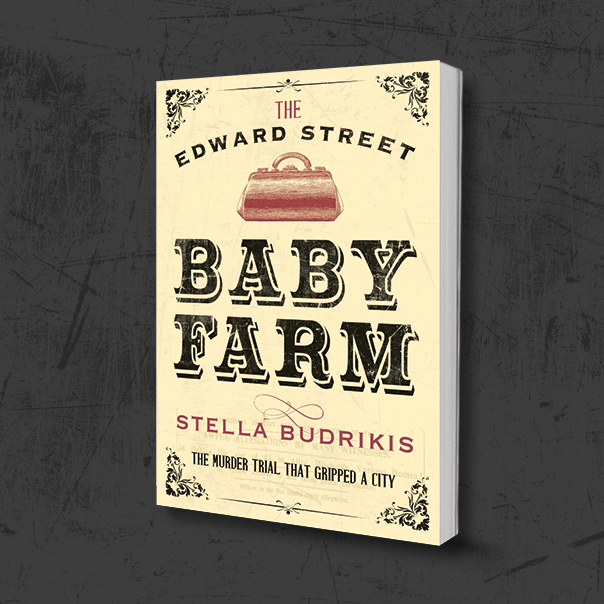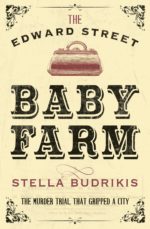It takes a special kind of author to look death in the face and write about it with humanity, clarity and compassion; Stella Budrikis is such an author

In the first decade of the twentieth century, the Alice Mitchell murder trial gripped the city of Perth and the Australian nation. Stella Budrikis’s book, The Edward Street Baby Farm, retraces this infamous tragedy – a tragedy that ultimately led to legislative changes in order to better protect children’s welfare. In this interview, Fremantle Press Publisher Georgia Richter asks the author to take us through the writing process and research methods behind this book.
Georgia: When you embark on a book-length project, do you personally find it important to already understand the parameters of the story?
Stella: I’ve only written two books. But in both cases, I’d say that although I’d already done a lot of research and had a rough idea of what shape the book would take when I started writing, it wasn’t until I finished several drafts that I had any sort of grip on the material.
When I started writing The Edward Street Baby Farm, I knew the basic outline of the story from the original newspaper reports and from more recent accounts. I’d also done some research into the lives of the main characters and the historical background. I knew roughly where I wanted the book to start and finish. But initially I wasn’t even sure whether I had enough information to actually write a full-length book about it.
I began by doing a rough draft of the whole story, more or less in chronological order, just to see what I had to work with. Once I’d done that, and I had something like 50,000 words, I knew that I could make something of it. The rough draft also helped me to see where I needed to do more research.
But then I had to make decisions about how to arrange the material. The main characters’ backstories were an important part of the story, but where should I introduce them? Lots of information that came out during the inquest into Baby Booth’s death was also brought up at the trial. Where should I place it? How much explanation did I need to give about things like Western Australia’s colonial history or infant mortality rates?
I also found, as I was working on the later drafts, that there were connections and patterns that I hadn’t seen before. Some of these seemed worth bringing out. Sometimes that meant rearranging material again.
So, although I could have told you what the book was about when I first started writing it, the finished book is very different to the first draft.
Georgia: What do you do when you encounter a barrier to your research or a lead that dries up?
Stella: Panic! For a while I’m like the rat in an experiment, repeatedly pressing the bar, hoping that the sweet treat will reappear. But eventually I accept that there’s no point in going over and over the same search. So I let it go for a while.
I’ve learned from experience that new material will often become available if I just wait. There’s new stuff being put online all the time. More and more information is being translated and catalogued and indexed. Or I might come across a source of information that I didn’t know about before while I’m looking for something else. Serendipity is a great research tool!
Sometimes I’ll wake up one morning and suddenly see a different approach I could take to finding the answer. Or I’ll talk it over with someone, and they might suggest a different approach that I hadn’t thought of.
If all else fails, I try to find a way to work around the gap in the research as I’m writing, so that it isn’t obvious.
Georgia: What, in your opinion, are the necessary ingredients for a story to become a book?
Stella: Obviously there has to be enough material available to build a book on. If there are no public records, no letters or diaries, no detailed newspaper reports, it becomes very difficult to fill a book. I’ve come across several fascinating characters and stories during my research, but I’m unlikely to write a book about them because the resources are just too sparse.
I think the next requirement is having one or more interesting characters at the centre of the story that both the author and the readers can relate to. They don’t need to be heroes – they can even be villains – but there has to be something about them that the writer and the reader can sympathise with. If I begin to feel a distaste for the main character, or I become bored with them, I soon let go of the idea of writing about them. I don’t want to spend two or three years writing about someone I can’t stand.
The story itself needs to have some identifiable beginning, middle and end, with the possibility of building tension as it goes along. If you’re writing a biography of someone famous, it might be okay to have a story that’s just ‘this happened and then that happened’. But the less well-known the characters, the more you need a good plot, and maybe a few subplots as well, to keep going, just as in fiction writing.
This might just be a personal preference, but I think the final element is that the story must have some lasting significance. The Alice Mitchell trial brought about changes to the child protection laws in Western Australia that still have effects today. Some of the themes that played out, such as how we treat the most vulnerable in society, are still relevant. That helped me keep going with writing and editing the book when I felt that I was just trudging along.
Georgia: What do you see as the skills required of the true crime researcher and writer?
Stella: I don’t think it’s a coincidence that many of the best true crime stories have been written by former journalists – people like Erik Larson, Kate Summerscale and John Berendt. Because of their journalism careers, they have an eye for a good story and can sense when there’s a deeper human-interest story behind the reported facts.
They also have the experience to know how and where to find the information they need. They can weigh up the value of what they’re reading. They collect small details that others might overlook as insignificant, like what someone was wearing, or the colour of the curtains, to add authenticity to the story.
They know how to organise the research material so they can find it again when they need it. And they have the courage to leave out material that doesn’t progress the story, even if they’ve spent hours researching it.
I don’t think any of these authors would describe themselves as ‘true crime’ writers. They apply the same skills to all their narrative non-fiction works.
Georgia: Why do you think readers are so fascinated by true crime when the themes can be so dark and the content confronting?
Stella: At the superficial level, there’s the novelty value. We might come across incidents of petty crime in our day-to-day lives, but murders and the like are unusual. And because they’re unusual, we’re curious about what happened. Why did it happen? What makes someone become a murderer or commit dreadful acts? Could it happen here, now?
At a deeper level, I think we all have a need to see justice done. The courts dispense justice as best they can, but there are still a lot of injustices in the world around us. We want to know that, in the end, the bad guys will get what they deserve, even if it’s only by having their lives exposed by a book.
And at the deepest level, we all have a dark side. We all have thoughts that we wouldn’t want others to know about, that maybe we deny even to ourselves. As we’re growing up, most of us learn to override these thoughts, and the desire to act in ways that are violent or cruel. But reading true crime stories helps us to explore that darker side of ourselves. It allows us to experience what it would be like if we were to act on our unacknowledged thoughts. Perhaps it even strengthens our ability to keep them under control.
The Edward Street Baby Farm is available in all good bookstores and online. Meet Stella at the official launch of her book, and many others, on Thursday 22 October at Fremantle Arts Centre.




